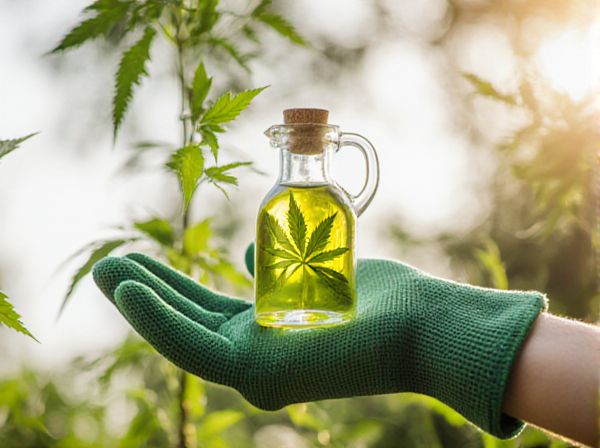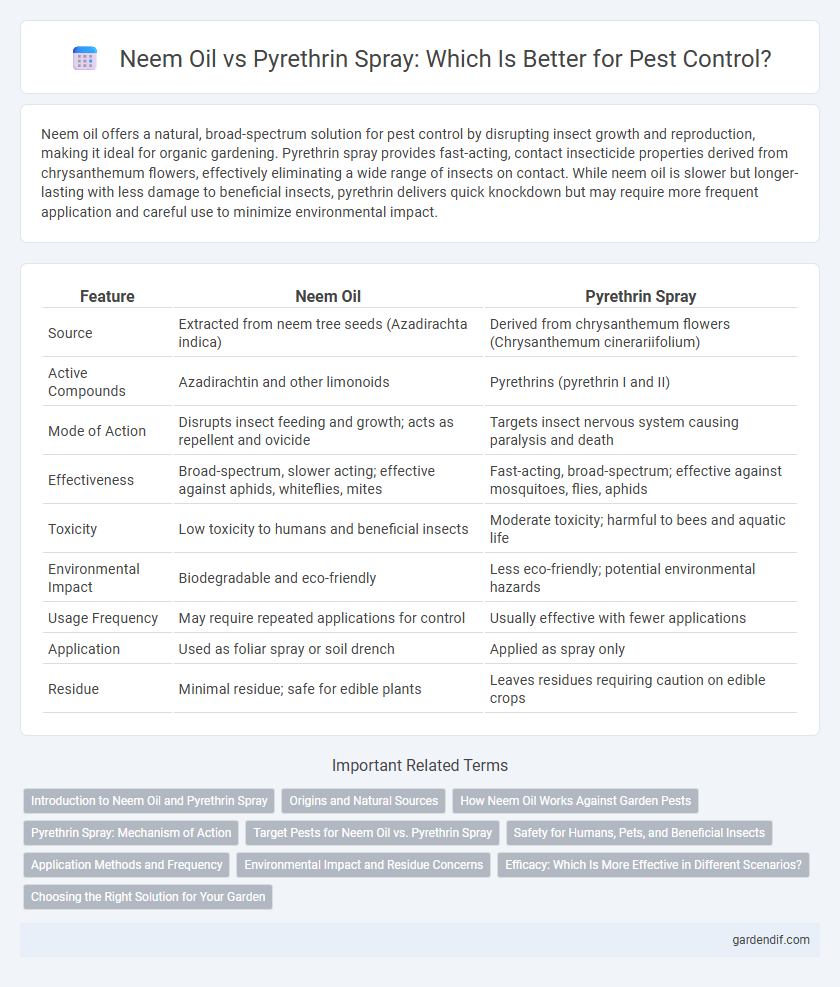
Neem oil vs pyrethrin spray Illustration
Neem oil offers a natural, broad-spectrum solution for pest control by disrupting insect growth and reproduction, making it ideal for organic gardening. Pyrethrin spray provides fast-acting, contact insecticide properties derived from chrysanthemum flowers, effectively eliminating a wide range of insects on contact. While neem oil is slower but longer-lasting with less damage to beneficial insects, pyrethrin delivers quick knockdown but may require more frequent application and careful use to minimize environmental impact.
Table of Comparison
| Feature | Neem Oil | Pyrethrin Spray |
|---|---|---|
| Source | Extracted from neem tree seeds (Azadirachta indica) | Derived from chrysanthemum flowers (Chrysanthemum cinerariifolium) |
| Active Compounds | Azadirachtin and other limonoids | Pyrethrins (pyrethrin I and II) |
| Mode of Action | Disrupts insect feeding and growth; acts as repellent and ovicide | Targets insect nervous system causing paralysis and death |
| Effectiveness | Broad-spectrum, slower acting; effective against aphids, whiteflies, mites | Fast-acting, broad-spectrum; effective against mosquitoes, flies, aphids |
| Toxicity | Low toxicity to humans and beneficial insects | Moderate toxicity; harmful to bees and aquatic life |
| Environmental Impact | Biodegradable and eco-friendly | Less eco-friendly; potential environmental hazards |
| Usage Frequency | May require repeated applications for control | Usually effective with fewer applications |
| Application | Used as foliar spray or soil drench | Applied as spray only |
| Residue | Minimal residue; safe for edible plants | Leaves residues requiring caution on edible crops |
Introduction to Neem Oil and Pyrethrin Spray
Neem oil, derived from the seeds of the Azadirachta indica tree, contains azadirachtin which disrupts insect growth and feeding behaviors, making it an effective natural pesticide. Pyrethrin spray is extracted from chrysanthemum flowers and targets the nervous system of insects, providing rapid knockdown and control of a broad spectrum of pests. Both products serve as organic options in pest management, each with unique modes of action suited for various agricultural and garden applications.
Origins and Natural Sources
Neem oil is derived from the seeds of the Azadirachta indica tree, native to the Indian subcontinent, and contains azadirachtin, which disrupts insect growth and reproduction. Pyrethrin spray is extracted from the dried flowers of Chrysanthemum cinerariifolium, a plant native to East Africa, and targets the nervous system of insects. Both are natural insecticides but differ significantly in their botanical origins and active compounds.
How Neem Oil Works Against Garden Pests
Neem oil works as a potent insecticide by disrupting the hormonal systems of garden pests, inhibiting their ability to feed, grow, and reproduce. It contains azadirachtin, an active compound that interferes with the molting process and deters insects such as aphids, whiteflies, and spider mites. Unlike pyrethrin spray, which provides rapid knockdown effects, neem oil offers a slower, systemic action that reduces pest populations while being safe for beneficial insects and plants.
Pyrethrin Spray: Mechanism of Action
Pyrethrin spray works by targeting the nervous system of insects, causing rapid paralysis and death through disruption of sodium ion channels. Derived from chrysanthemum flowers, pyrethrins act quickly on contact, making them highly effective for immediate pest control. This mechanism limits the likelihood of pests developing resistance compared to other chemical insecticides.
Target Pests for Neem Oil vs. Pyrethrin Spray
Neem oil effectively targets a wide range of pests including aphids, whiteflies, spider mites, and scale insects by disrupting their hormonal balance and feeding patterns. Pyrethrin spray quickly knocks down pests such as mosquitoes, flies, ants, and beetles through neurotoxicity, providing rapid contact kill. While neem oil offers prolonged pest control with systemic action, pyrethrin spray excels at immediate eradication of surface-active insects.
Safety for Humans, Pets, and Beneficial Insects
Neem oil is generally safer for humans, pets, and beneficial insects due to its natural origin and low toxicity, posing minimal risk when used as directed. Pyrethrin spray, though derived from chrysanthemum flowers, can be more toxic to cats, aquatic life, and pollinators like bees, requiring careful application to avoid harm. Both products require adherence to safety guidelines, but neem oil is often preferred for integrated pest management because of its selective impact and biodegradability.
Application Methods and Frequency
Neem oil is typically applied as a foliar spray or soil drench, requiring reapplication every 7 to 14 days to maintain effectiveness against pests like aphids and mites. Pyrethrin spray, derived from chrysanthemum flowers, acts rapidly upon contact and is usually applied every 5 to 7 days or after rainfall due to its quick degradation. Consistent application frequency tailored to pest pressure and environmental conditions ensures optimal pest control with both neem oil and pyrethrin spray.
Environmental Impact and Residue Concerns
Neem oil is biodegradable and poses minimal risk to beneficial insects, making it environmentally friendly with low residue persistence. Pyrethrin spray, while natural, can be toxic to aquatic life and beneficial pollinators, causing greater environmental concerns due to its rapid breakdown into more harmful compounds. Residue from pyrethrin may linger on plants, whereas neem oil typically leaves harmless residues that degrade quickly under sunlight.
Efficacy: Which Is More Effective in Different Scenarios?
Neem oil and pyrethrin spray offer distinct pest control efficacies based on pest type and infestation severity. Neem oil disrupts insect growth and feeding, making it highly effective against soft-bodied pests like aphids and mites in organic gardening. Pyrethrin spray provides rapid knockdown of a broad spectrum of insects, including beetles and flies, proving more efficient for acute infestations and fast action in conventional pest management.
Choosing the Right Solution for Your Garden
Neem oil and pyrethrin spray serve distinct pest control roles in garden management, with neem oil offering a natural, systemic solution effective against a broad spectrum of insects and fungal issues. Pyrethrin spray provides rapid knockdown of soft-bodied pests but tends to have a shorter residual effect, requiring more frequent application. Selecting between neem oil and pyrethrin depends on pest type, environmental safety preferences, and persistence needed, making neem oil ideal for long-term integrated pest management and pyrethrin suitable for immediate, acute infestations.
Neem oil vs pyrethrin spray Infographic

 gardendif.com
gardendif.com